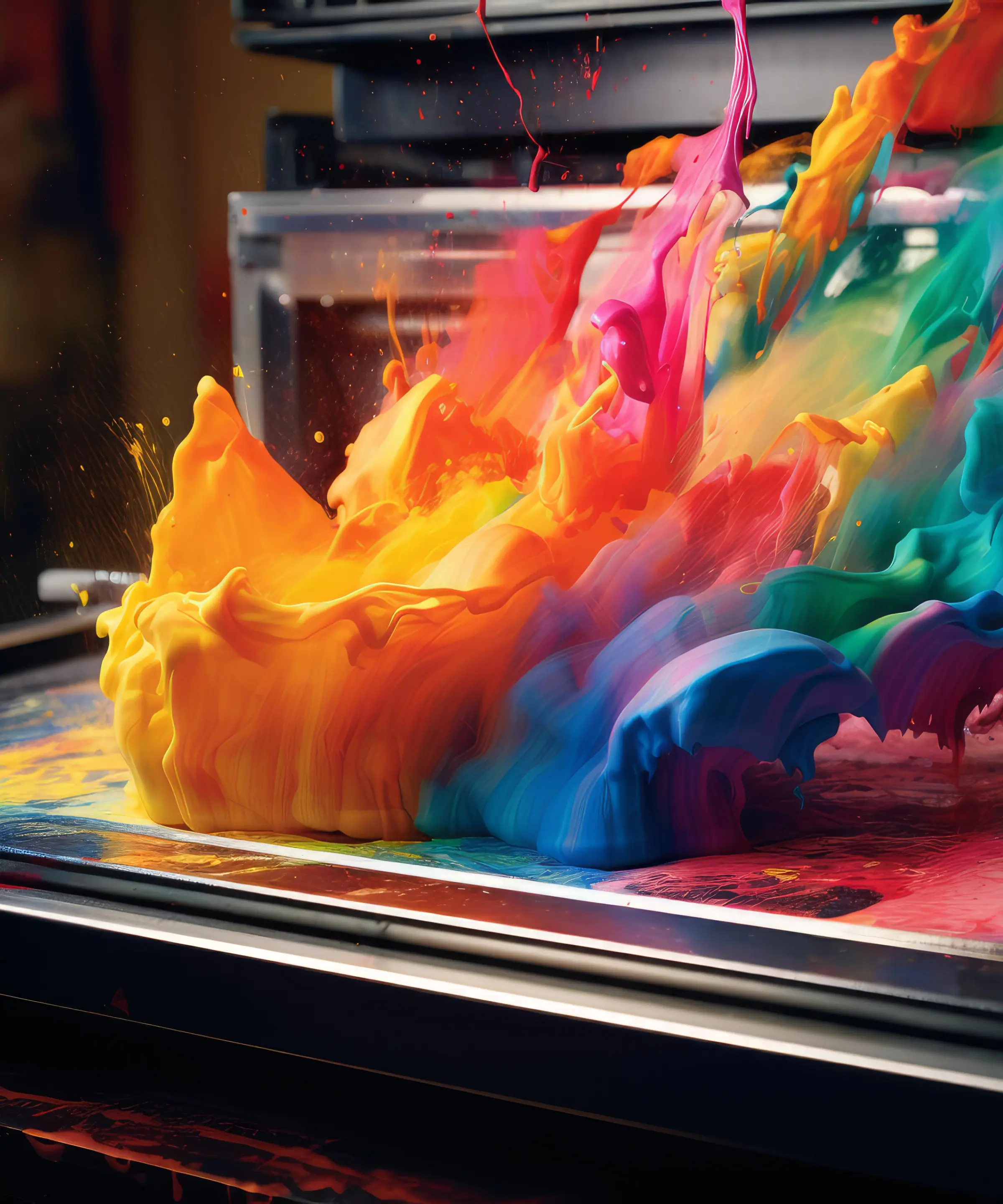The Printing Process: More Than Just Hitting 'Print'
Material Selection – Flex banners come in two primary types: front-lit (for daytime visibility) and back-lit (for glowing effects at night). Choose wisely—unless you want your midnight birthday party banner to disappear into the darkness.
Ink Matters – Ever seen a flex banner that looks like it went through a car wash in slow motion? That’s low-quality ink for you. High-quality solvent, eco-solvent, or UV-resistant inks ensure that your banner doesn’t fade faster than your enthusiasm for gym memberships in January.
Printing It Big – Flex banners are printed using large-format digital printers, which can churn out massive prints without losing quality. Think of them as the muscle-bound bodybuilders of the printing world.
Finishing Touches – After printing, banners are trimmed, reinforced, and sometimes fitted with eyelets (those little holes that make hanging them a breeze). Because a banner that won’t stay up is as useful as an umbrella in a hurricane.
The Good, The Bad, and The Hilariously Ugly
Not all flex banners are created equal. Some are crisp and vibrant, and look like they belong in an art gallery. Others… well, they make you wonder if someone’s nephew printed them as a school project.
-
The Good
- High-resolution printing that doesn’t make people look like pixelated Minecraft characters.
- Durable material that won’t tear at the first gust of wind.
- Proper colour management so your logo doesn’t come out neon green when it was supposed to be deep blue.
-
The Bad
- Poor-quality ink that fades faster than your New Year’s resolutions.
- Low-resolution images that make faces look like abstract art.
- Crooked text that screams “rushed job.”
-
The Hilariously Ugly
- Misspelled words that change the entire meaning. (“Happy Birthday” is a classic.)
- Unintended hilarious translations. (“Grand Opening” becoming “Grind Opening” is a real thing.)
- Banner placements gone wrong—like a politician’s face perfectly lined up with a lamp post.
Why Flex Banners Are Still King
Despite the occasional disaster, flex banners remain the undisputed champions of signage. Wanna know why? Let’s dive into it.
Cost-Effective – You get massive visibility without spending a fortune. Why pay thousands for an LED screen when a well-printed banner does the job just fine?
Versatile – From trade shows to weddings, there’s no event too big or small for a flex banner.
Weather-Resistant – Rain or shine, your banner keeps doing its thing.
Customizable – Any size, any colour, any message—your imagination is the only limit (well, that and grammar).
The Future of Flex Banner Printing
While flex banners continue to dominate, new printing techniques and eco-friendly materials are making their way into the industry. Biodegradable flex materials and water-based inks are reducing environmental impact, ensuring that your eye-catching banner doesn’t end up haunting the planet for centuries.
At the same time, digital advancements mean sharper images, better colour accuracy, and even interactive elements. Yes, QR codes on banners are becoming a thing—so instead of handing out flyers, you can just tell people to scan your massive sign. Efficiency at its finest!
Conclusion: Print Smart, Print Right
Flex banners are a powerful tool—when done right. They grab attention, deliver messages, and sometimes provide unintentional comic relief. Whether you’re advertising your business, promoting an event, or just trying to embarrass your friend on their birthday, make sure you invest in high-quality printing.
So, the next time you see a massive banner outside a store, a stadium, or hanging on a building with a questionable font choice—give it a nod of appreciation. That’s flex printing at work, baby!
The terms “hoarding” and “billboard” are influenced by regional preferences. In the UK, “hoarding” is commonly used, whereas Americans prefer “billboard.” This difference has persisted despite globalization, and knowing where you are in the world can help determine which term people are likely to use.
Defining Hoardings
Hoardings typically refer to large advertising structures found in urban environments, often placed around construction sites or temporary spaces. They serve a dual purpose: providing privacy and security around a construction area while also being prime real estate for advertisers.
Features of Hoardings:
Hoardings are often installed for a limited period, making them temporary advertising structures. They are primarily found in busy urban areas where they capture the attention of pedestrians and city commuters.
In addition to being advertising platforms, hoardings also act as barriers around construction sites or other restricted spaces. Since they are placed at eye level, they tend to feature more detailed designs that captivate attention at a slower pace.
Fun Fact:Hoardings date back to medieval times when they were used as makeshift wooden fencing on fortresses. Imagine trying to stick an ad for medieval ale on that!
Understanding Billboards
Billboards, on the other hand, are fixed, large-scale advertising structures designed primarily for visibility from a distance, often near highways and high-traffic roads.
Features of Billboards:
Billboards are permanent structures that remain in place for extended periods, often dominating the landscape along major highways and expressways. They are designed with simplicity in mind, relying on bold and concise messages that can be quickly understood by passing motorists. Positioned at elevated heights, billboards ensure maximum visibility, even in visually cluttered environments.
Pro Tip: A well-crafted billboard should convey its message in 6 seconds or less—the average time it takes a driver to read it.
The Visual and Design Differences
When designing for hoardings and billboards, advertisers must tailor their approach:
Hoardings can have more detailed information because pedestrians have time to read, while billboards require short, impactful messages. Bright, bold images work well on billboards, whereas hoardings can accommodate intricate visuals and storytelling elements. Since hoardings are viewed up close, they tend to have more detailed visuals, while billboards are designed to be seen from a distance.
Example Comparison:
A hoarding for a fashion brand might show multiple models with intricate patterns and detailed text about an upcoming sale. In contrast, a billboard for the same brand would likely feature a single model with just “50% Off! This Weekend Only!” in big, bold letters.
When to Use Hoardings vs. Billboards
Hoardings are great for capturing urban foot traffic, while billboards target motorists and long-distance travelers. For temporary events or campaigns, hoardings are ideal, whereas billboards work better for long-term brand awareness.
Budget considerations also play a role—hoardings can be more affordable depending on location and size, while billboards often require a higher investment due to their premium placements.
Real-World Examples
A tech company might use a massive hoarding near a bustling construction site to announce the launch of a new product. Curious commuters see it every day, building anticipation.
On the other hand, a beverage brand might place a vibrant, witty billboard on a highway leading to a popular vacation spot, ensuring travelers crave a cold drink by the time they reach their destination.
The Digital Revolution: Static vs. Dynamic Content
Both hoardings and billboards have embraced the digital age. Digital billboards, which can rotate multiple ads, are becoming more common along highways. Similarly, digital hoardings are being used in urban spaces to engage tech-savvy audiences.
Pro Tip:Dynamic digital content allows advertisers to change messages based on time, weather, or audience demographics—making campaigns more relevant and engaging.
Common Misconceptions
Many people believe that hoardings are just for construction sites, but this is not true. While they are often seen around construction zones, hoardings are used in many other urban spaces.
Another misconception is that billboards are always rectangular; however, modern billboards come in creative shapes and 3D designs to grab attention. Additionally, some think one is better than the other, but in reality, each has its own strengths depending on the campaign goals.
Choosing the Right Medium
Whether you’re an advertiser planning your next campaign or just someone curious about the world of outdoor advertising, knowing the difference between hoardings and billboards can be enlightening. Think of hoardings as the detailed storytellers of urban environments and billboards as the bold headline-makers of the open road.
Next time you spot a giant ad while strolling through the city or driving on the highway, you’ll know exactly what to call it—and maybe even impress your friends with your newfound knowledge. Happy ad spotting!




Leave A Reply